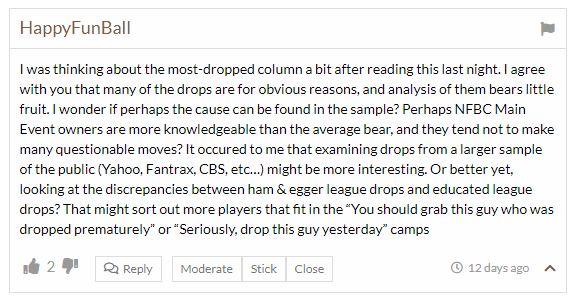Comparing Various Website Drop Lists
First, sorry about no drop list article last week… more on that later. Second, today’s experiment stems from HappyFunBall’s comment from a couple of weeks ago.

I was well into the analysis last week and found I was not answering the right question and had the wrong data. The drop comparisons need to be a little forward-looking, not backward. The data collected from the sites was after the NFBC FAAB ran. The other sites I used allow daily or quick-draw pickups, so some of the news from the Monday was getting baked in. I wanted the rates to be taken from similar timeframes.
My original question focused on which players I should analyze so owners can gain an edge. The edge could be knowing who to drop because they are no longer fantasy-viable. Also, the hope is to find some players whose owners gave up too early on. The hope is that one of the other platforms can provide more insight than the NFBC Main Event.
Several issues exist with this study. First, it’s just one week and a busy week at that with the trade deadline. The increased activity may help to offset the lack of moves since it’s later in the season. I’m not 100% sure but I may run the same analysis again but I need to do it before the head-to-head playoff start and main teams get abandoned.
Finally, the table is a mess. A big one. What Happy Fun Ball and I hoped for didn’t materialize but a few interesting observations can be made.
